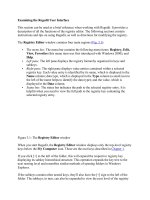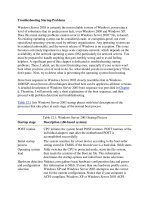Tài liệu Using SQL phần 1 doc
Bạn đang xem bản rút gọn của tài liệu. Xem và tải ngay bản đầy đủ của tài liệu tại đây (55.69 KB, 9 trang )
Using SQL
SQL (pronounced sequel) is the standard language for accessing relational databases. As
you'll see in this chapter, SQL is easy to learn and use. With SQL, you tell the database
what data you want to access, and the database software figures out exactly how to get
that data.
There are many types of SQL statements, but the most commonly used types of SQL
statements are these:
•
Data Manipulation Language (DML) statements
•
Data Definition Language (DDL) statements
DML statements allow you to retrieve, add, modify, and delete rows stored in the
database. DDL statements allow you to create database structures such as tables.
Before you learn the basics of DML statements, you need to know how you can enter and
run SQL statements. You can enter and run SQL statements against a SQL Server
database using the Query Analyzer tool, and you'll learn about this next.
Note As you'll see later in the "Accessing a Database Using Visual Studio .NET" section,
you can also use Visual Studio .NET to create SQL statements. Visual Studio .NET
enables you to create SQL statements visually, as well as entering them manually.
Using Query Analyzer
You use Query Analyzer to enter and run SQL statements. You start Query Analyzer by
selecting Start ➣ Microsoft SQL Server ➣ Query Analyzer. In the following sections,
you'll learn how to connect to a SQL server instance, enter and run a SQL statement, save
a SQL statement, and load one.
Connecting to a SQL Server Instance
When you start Query Analyzer, the first thing it displays is the Connect to SQL Server
dialog box, as shown in Figure 3.1
. In the SQL Server field, you enter the name of the
SQL Server instance to which you want to connect. You can click the drop-down list and
select an instance of SQL Server, or you can click the ellipsis button (three dots …) to the
right of the drop-down list to display a list of SQL Server instances running on your
network.
Figure 3.1: Connecting to a SQL Server database
If you select the Windows authentication radio button, then SQL Server will use the
Windows 2000/NT user information to validate your request to connect to SQL Server. If
you select the SQL Server authentication radio button, then you will need to enter a login
name and password.
In Figure 3.1
, I've entered localhost in the SQL Server field; this corresponds to the
instance of SQL Server installed on the local computer. I've also selected the SQL Server
authentication radio button, and entered sa in the Login Name field and sa in the
Password field (this is the password I used when installing SQL Server). These details are
then used to connect to SQL Server. If you have an instance of SQL Server running on
your local computer or on your network, you may enter the relevant details and click the
OK button to connect to SQL Server.
Now that you've seen how to connect to the database, let's take a look at how you enter
and run a SQL statement.
Entering and Running a SQL Statement
Once you've connected to SQL Server using Query Analyzer, you can use the Object
Browser to view the parts of a database, and you enter and run SQL statements using a
Query window. Figure 3.2
shows the Object Browser and an example Query window,
along with the results of retrieving the CustomerID and CompanyName columns from the
Customers table.
Figure 3.2: Viewing database items using the Object Browser and executing a SELECT
statement using the Query window
As you can see from Figure 3.2
, you enter SQL statements into the top part of the Query
window, and the results retrieved from the database are displayed in the bottom part. You
specify the database to access with the USE statement, and you retrieve rows from the
database using the SELECT statement.
Tip You can also specify the database to access by using the drop-down list on the
toolbar.
If you want to follow along with this example, go ahead and enter the following USE
statement into your Query window:
USE Northwind
This USE statement indicates that you want to use the Northwind database. Next, on a
separate line, enter the following SELECT statement:
SELECT CustomerID, CompanyName FROM Customers;
This SELECT statement indicates that you want to retrieve the CustomerID and
CompanyName columns from the Customers table.
Note SELECT and FROM are SQL keywords. Although SQL isn't case sensitive, I use
uppercase when specifying SQL keywords and mixed case when specifying column
and table names. You may terminate a SQL statement using a semicolon (;),
although this isn't mandatory.
You can run the SQL statement entered in the Query window in five ways:
•
Selecting Execute from the Query menu
•
Clicking the Execute Query button (green triangle) on the toolbar
•
Pressing the F5 key on the keyboard
•
Pressing Ctrl+E on the keyboard
•
Pressing Alt+X on the keyboard
Once you run the SQL statement, your statement is sent to the database for execution.
The database runs your statement and sends results back. These results are then displayed
in the bottom of your Query window.
Saving and Loading a SQL Statement
You can save a SQL statement previously entered into Query Analyzer as a text file.
Later, you can load and run the SQL statement saved in that file. You can save a SQL
statement by
•
Selecting Save or Save As from the File menu
•
Clicking the Save Query/Result button (disk) on the toolbar
•
Pressing Ctrl+S on the keyboard
When you do any of these, the Query Analyzer opens the Save Query dialog box. Let's
say you save the file as CustomerSelect.sql. Once you've saved the file, you can open it
by
•
Selecting Open from the File menu
•
Clicking the Load SQL Script button (open folder) on the toolbar
•
Pressing Ctrl+Shift+P on the keyboard
When you do any of these, the Query Analyzer opens the Open Query File dialog box.
Let's say you open CustomerSelect.sql. Once you've opened a query file, you can run it
using one of the techniques described earlier.
Understanding Data Manipulation Language (DML) Statements
As mentioned earlier, DML statements enable you to retrieve, add, modify, and delete
rows stored in database tables. There are four types of DML statements:
•
SELECT Retrieves rows from one or more tables.
•
INSERT Adds one or more new rows to a table.
•
UPDATE Modifies one or more rows in a table.
•
DELETE Removes one or more rows from a table.
You'll learn how to use these four statements in the following sections.
Retrieving Rows From a Single Table
You use the SELECT statement to retrieve rows from tables. The SELECT statement has
many forms, and the simplest version allows you to specify a list of columns and the
table name. For example, the following SELECT statement retrieves the CustomerID,
CompanyName, ContactName, and Address columns from the Customers table:
SELECT CustomerID, CompanyName, ContactName, Address
FROM Customers;
The columns to retrieve are specified after the SELECT keyword, and the table is
specified after the FROM keyword.
If you want to retrieve all columns from a table, specify the asterisk character (*)
immediately after the SELECT keyword.
Tip To avoid retrieving more information than you need, rather than use *, list only the
columns you actually want.
For example, the following SELECT statement retrieves all the columns from the
Customers table using *:
SELECT *
FROM Customers;
Figure 3.3
shows the results of this SELECT statement.
Figure 3.3: Using a SELECT statement to retrieve rows from the Customers table









